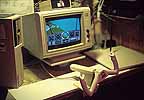
Path: Home Page > [Services >] Articles > Articles Background
It all began when I was commissioned to write an article about flight simulators for the Swedish microcomputer magazine Mikrodatorn in 1989. The article Make your computer useful after 5 o'clock (Låt datorn göra nytta efter 5) in 3 pages, was my start in the journalistic business. It covered flight simulators, copy protection, and accessories to aid the computer pilot. I also supplied the illustrations myself.
Stay on Track |
Computer journalism is a mixture of technical know-how, and being able to get under the skin of more or less successful products. At the same time you can not loose your humour or forget the user. During the years since 1989, I have written more than a hundred articles and other texts, taking various forms, such as:
I have often been hired to write all, or parts of corporate newsletters dealing with computers. Articles about hard technology, such as software for mini computers or the technology driving automated faxback systems, as well as less technological texts, such as the computer safety at the Swedish Forsmark nuclear power plant, or about consultant companies taking new directions. I can write an article, or design the complete newsletter. Maybe you need some new graphical ideas?
|
|
If you want to read one of my articles, which got a really warm reception, click here. It's all about wireless local networks. | Another article, that got lots of laughs was my scientific investigation of how best to blow up CD-ROMs. Its right here. |
Documentary Trips |
Its diameter of 305 metres makes the Arecibo Telescope the world's biggest antenna, and the Earth's ear to Universe It is so sensitive it can hear a walkie-talkie on Pluto. Should an extraterrestrial civilisation transmit something to us, Arecibo is the place to hear it first. I was lucky enough to be able to go there, reporting on SETI, the Search for Extraterrestrial Intelligence..
The rattling jeep climbs higher and higher on the mountain ridge. Suddenly the steaming jungle folds away, and there it is! It spreads out like a grey-white ocean, a giant opening in the jungle, the largest antenna in the world. A softly curving aluminium surface, resting on several hundred steel cables in a natural sinkhole in the mountainous Puerto Rico heartland. The feeling when standing close to Earth's big ear to the Universe is overwhelming. If we make contact with aliens, here's the place where it will happen. In front of me is a bowl-shaped metal net, 10 football fields in size, but apart from the cackling of parrots, nothing can be heard. The noise of Space is as remote here as anywhere else on Earth, yet here it is more obvious than at any other place. Stars rumble, pulsars thunder like steam engines or wail like sirens, awhile the background of the Universe softly murmurs. Inside the station, the instruments show that Universe is full of activity..
This is a technical dive into all the treasures of the Arecibo Observatory. For general chit-chat about Puerto Rico and the cities around the observatory, go here. Some very tasty panoramas can be found here.
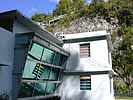 |
The Control Room has big panoramic windows facing the lovely view. You also see some of the installations on the mountain in behind, facing up towards the Visitor's Centre. |
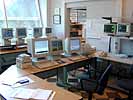 |
In the Control Room the antenna focus and how it should scan the Universe is programmed. The two trains that turn The Gaussian, the receiver house hanging in wires in the focal point, are run from here. Here is also where the catalogues of celestial objects are stored, and before pulsars were actually confirmed to be spinning neutron stars back in the 1970's, they were all catalogued as L.G.M. and a serial number, meaning “Little Green Men”. |
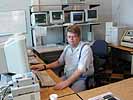 |
Here I am in the pilot's chair in the Control Room, in front of the main terminal. I have actually shared this chair with Jodie Foster in the “Contact” movie, written by Carl Sagan. In the movie she sits in this very chair, listening for alien civilisations. Of course, in reality no one uses headphones, but it looked good on film. Also note the nicely packaged arm injury. |
 |
The most beautiful I have ever seen in the field of radio, the Intermediate Frequency Room. The picture shows part of the intermediate frequency for the astronomical receivers and five racks containing the interplanetary radar of 2 and 6 GHz. All the racks are detailed on the panorama page. |
 |
Here are the two finest panels in the whole collection, the intermediate frequency units for the 430 MHz receiver. The two racks are identical, and take care of clockwise and anticlockwise polarisation respectively. There are no permanent connections, instead every scientist connects the way he wants with patch cables, much like an electronic kit. |
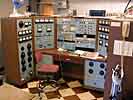 |
A vintage machine with muscle, is this control panel for the interplanetary radar on 430 MHz, at 1 MW. With the 75 dB of antenna gain, 1 MW will look like a “light” many times brighter than the sun on the radio astronomical sky. This panel was used for the radar mapping of Mercury. No computer in this one, only big, beefy knobs. Something to hold on to. |
 |
Left to its own in a corner stands The Mark III Pulsar Machine, a computer rack set up specifically for finding pulsars. It has a special way to avoid the Year 2000 problem: the system clock is to be turned back 20 years. Guaranteed to work. |
 |
In a little nook outside the IF room we find the kitchen. It may not be the thing for a culinary feast, but is alright for fixing some grub during an all night hack. |
To be able to understand how sensitive the receiver is I asked the scientists if they were able to hear a walkie-talkie
on Pluto. It set off a fair bit of calculating, but the answer was quite fast.
- No problems. We regularly listen to weaker signals than that.
We had calculated with the walkie-talkie using 3 watts, but Project Phoenix that monitors between 1 and 3 GHz,
uses the Pioneer 10 spaceprobe for reference, transmitting 1 watt at 11 billion kilometres distance,
way outside the Solar system.
There are radio amateurs enjoying bouncing signals off the Moon, so called moon bouncers or EME, communicating that way. To hear the reflections are somewhere between “difficult” and “impossible”. One night after the “upgrade” there were some leftover observation time, and the antenna was directed at the Moon. The receiver was full of clattering radio amateurs, though they could barely hear each other. The reflection attenuation from the Moon is approximately 250 dB, so the signals coming back are understandably very small.
See also the Observatory home page at www.naic.edu/home.htm about the radar mapping of Mercury. That was the finest science I have ever seen.
The final piece of evidence, me posing in front of all the splendour, on the balcony outside the Control Room panoramic window. This is where they had the party in the “Contact” movie..
This was no ordinary article, it became the Best Article in N&K of 2000, 10 pages long.
The pilot ignites the afterburner and a blue flame roar out with a rumble that can be heard several kilometres. “Cleared for Take-off” comes the answer from the tower, and when he releases the brakes, the plane jumps ahead. Even though the pilot is trained, the smell of death tingles in his stomach. “Now we'll have another kind of tingles,” he thinks, as he pulls the stick. Only the G-suit stops his stomach from ending up between his knees. He breaks the sound barrier with a pressure wave that nearly rips the roof of a little cottage below, on his way toward the enemy. “He hasn't got his radar on. Then he can't see me. But I can see him!” The enemy plane comes nearer his missile's firing range on the tactical indicator and soon it's there. Now! “Fire” comes the calm voice of Gripen, and the pilot's index finger makes a deadly move towards the trigger. The plane rocks a little as the AMRAAM missile leaves the wingtip and disappears forward as a white line. He follows it on his screen, and sees his colleagues around him, waiting. “Don't mess with a Swede,” he thinks as he sees a fireball exploding at the horizon, a sign that the missile did its job. He throws the plane in a tight curve, to avoid any shrapnel from the explosion. He flies the same way back, but he leaves the little cottage unharmed this time. “A cup of coffee would be real nice now,” he thinks, after touchdown, when he walks off the tarmac towards the camp.
It may seem a bit odd that a computer-tech journalist writes about aeroplanes, but if you look closely at the pride of the Swedish aircraft industry, the Gripen warplane, you will find that this trip was entirely justified. As the Nätverk & Kommunikation is not a aeroplane magazine, I had no interest in flying properties and armament. Lots of people have written about that already. Instead, I was interested in the computer systems and the network on board.
Gripen contains a lot of new Swedish thinking, and perhaps the computer link (Jaktlänken), the possibility for videoconferencing between pilots on a mission, is the best of all. The pilots can communicate electronically, sharing missions, weapons, targets, and most of all, radar images. This enables most of the aircraft to fly with their radar off and remain undetected. Only one plane has to reveal itself, using its radar. Alternatively, the images from the Swedish ground radar network may be used. Planes on the ground can listen in, too and take part in the fighting electronically, so they wil loose no time, when they finally does get in the air..
There are many computers and networks to explore in Gripen. The machines has 40 computers on board, communicating via MIL-STD 1553B type data buses. Viewed as a computer workstation, which is what it basically is, it is a multiprocessor machine with three colour graphic screens, voice command (yes, Gripen talks to its pilot, and the pilot can talk back), and advanced possibilities for videoconferencing over secure radio links. Everything is controlled by simply pointing-and-clicking, using the joystick.
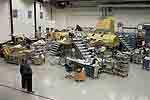 Saab's assembly hall in Linköping,
Sweden is a miracle of cleanliness. Highly skilled technicians carry out precision craftsmanship. No car mechanics
here! The hall is so clean it could be used as ballroom.
Saab's assembly hall in Linköping,
Sweden is a miracle of cleanliness. Highly skilled technicians carry out precision craftsmanship. No car mechanics
here! The hall is so clean it could be used as ballroom.
 Ready to kill, with the
Data Transfer Unit (DTU). The pilot can enter his flight plan into it, in a secure environment, then bring it to
the aircraft, plug it in and be off in a minute. A Swedish innovation. In American planes, the pilot has to key
in the flight plan by hand, sitting in the plane, vulnerable to attack. After the mission, all the mission data
is in the DTU, and may easily be taken along to the camp and analysed.
Ready to kill, with the
Data Transfer Unit (DTU). The pilot can enter his flight plan into it, in a secure environment, then bring it to
the aircraft, plug it in and be off in a minute. A Swedish innovation. In American planes, the pilot has to key
in the flight plan by hand, sitting in the plane, vulnerable to attack. After the mission, all the mission data
is in the DTU, and may easily be taken along to the camp and analysed.
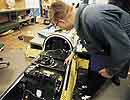 This spring-mounted platform is
for the video tape recorder, used for recording the whole mission. The space I'm looking into is located right
behind the pilot's chair. No video tape recorder in the world can take the vibrations when the Muaser cannon is
fired, so the recorder has to be spring-mounted. It is planned to replace it with a solid state device.
This spring-mounted platform is
for the video tape recorder, used for recording the whole mission. The space I'm looking into is located right
behind the pilot's chair. No video tape recorder in the world can take the vibrations when the Muaser cannon is
fired, so the recorder has to be spring-mounted. It is planned to replace it with a solid state device.
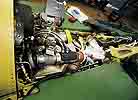 Gripen's got guts, and they are
red, and look like this. It's the air conditioning, which cools the computers and works the climate for the pilot
in the cockpit.
Gripen's got guts, and they are
red, and look like this. It's the air conditioning, which cools the computers and works the climate for the pilot
in the cockpit.
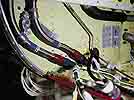 Gripens worst enemy is various kinds of invisible
electromagnetic interference. To withstand the threat from NEMP, EMI, radar, radio transmitters and other emitters,
the computer network is laid out inside heavily screened cables. You see the braided sheaths in the picture. The
screen is grounded to the aircraft body with short, wide braids, all according to the textbook. The EMI work done
on Gripen is impressive.
Gripens worst enemy is various kinds of invisible
electromagnetic interference. To withstand the threat from NEMP, EMI, radar, radio transmitters and other emitters,
the computer network is laid out inside heavily screened cables. You see the braided sheaths in the picture. The
screen is grounded to the aircraft body with short, wide braids, all according to the textbook. The EMI work done
on Gripen is impressive.
For copyright reasons, I cannot publish the article that became the result of the visit, but you may order it from IDG AB in Stockholm, Sweden (only in Swedish), and find it on IDG's web site at www.idg.se. Look under Nätverk & Kommunikation. As long as the stock holds up you may also order reprints. Finally, some goody flying pictures for your amusement (Published by kind permission of Saab. The pictures may not be used commercially.)
|
Gripen over the Andes, Chile |
Gripen over the Andes, Chile |
Gripen with AMRAAM |
Gripen with AMRAAM |
Gripen formation with fighter load |
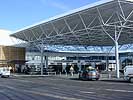 The article I
wrote about Gripen was so immensely popular ("The best we ever had" one member of the staff hissed, who
wants to remain anonymous) that the Nätverk & Kommunikation editorial office decided to create a whole
exhibition booth around it, at the Computerworld Expo 2000 in Stockholm in April. Saab Aerospace provided a whole
Gripen aircraft and managed to budge it into the 140 m2 booth. By the sides people could sit and
relax in a café, get reprints of the article and get a bit of the proper Air Force feeling.
The article I
wrote about Gripen was so immensely popular ("The best we ever had" one member of the staff hissed, who
wants to remain anonymous) that the Nätverk & Kommunikation editorial office decided to create a whole
exhibition booth around it, at the Computerworld Expo 2000 in Stockholm in April. Saab Aerospace provided a whole
Gripen aircraft and managed to budge it into the 140 m2 booth. By the sides people could sit and
relax in a café, get reprints of the article and get a bit of the proper Air Force feeling.
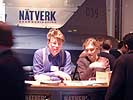
 Not everyone has an exhibition booth at a computer exhibition tailor-made to a magazine
article. Here is Yours Truly at the booth desk, handing out article reprints, and being a terrible braggart in
general. The other picture shows me sitting below a wall-version of the article in the café department.
Not everyone has an exhibition booth at a computer exhibition tailor-made to a magazine
article. Here is Yours Truly at the booth desk, handing out article reprints, and being a terrible braggart in
general. The other picture shows me sitting below a wall-version of the article in the café department.

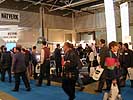
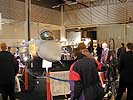 Of course a Swedish warplane
attracts peoples interest. Here are some pictures of people clustering around the machine. It was a non-operative,
full-scale model, but everything on the outside was authentic, the fuselage material, the landing gear, etc.
Of course a Swedish warplane
attracts peoples interest. Here are some pictures of people clustering around the machine. It was a non-operative,
full-scale model, but everything on the outside was authentic, the fuselage material, the landing gear, etc.


 Aircraft
invites to some technical shooting. I crawled around under the machine and on the wings to get some nice angles.
In the last picture I show that air-to-air missiles can be used as armrests, too.
Aircraft
invites to some technical shooting. I crawled around under the machine and on the wings to get some nice angles.
In the last picture I show that air-to-air missiles can be used as armrests, too.
Commissioned by the Nätverk & Kommunikation magazine I went to Rotterdam in Holland, to Europe's largest harbour, to have a look at some automatic loading trucks controlled by wireless LAN.
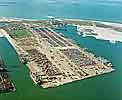 ECT (Europe Combined Terminals) is
a 100-hectare area, through which some 4 million containers flow each year. They are offloaded from the ships by
enormous cranes, and put on automatic diesel-powered loaders that will move them to an intermediate storage area,
where they again will be lifted by automatic high lifting cranes, and taken to trains or lorries. The giant ship
cranes have human drivers, three of them to make sure nothing is missed, but apart from this, no humans are involved.
The pace of work is simply too high! The driverless vehicles need to be in constant radio communication with the
computer system. For this, a wireless 2.4 GHz CSMA network from Israeli Breezecom is employed.
ECT (Europe Combined Terminals) is
a 100-hectare area, through which some 4 million containers flow each year. They are offloaded from the ships by
enormous cranes, and put on automatic diesel-powered loaders that will move them to an intermediate storage area,
where they again will be lifted by automatic high lifting cranes, and taken to trains or lorries. The giant ship
cranes have human drivers, three of them to make sure nothing is missed, but apart from this, no humans are involved.
The pace of work is simply too high! The driverless vehicles need to be in constant radio communication with the
computer system. For this, a wireless 2.4 GHz CSMA network from Israeli Breezecom is employed.
The driverless vehicles are very impressive. They orient along wire loops in the 2-km long quay, but get their orders through the wireless network all the time. They are diesel engine powered 7-ton automatic giants that will blink the blinker very nicely when they turn, look out for each other, and park with an accuracy of only a few centimetres. Continuous radio contact is of the outmost essence. If the contact is lost, the vehicle will stop, and because of this there are some 20 microwave antennas spread out over the area. They had great problems with multipath propagation, as microwaves bounce off everything metallic (such as ships, cranes and containers) and creates complicated patterns of radio shadows. The pattern is changing all the time, as ships come and go and cranes move. Anyhow, the problems have been overcome, partly by placing a lot of antennas in the right places, partly by adapting the algorithms inside the microwave units to the situation.
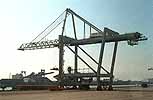 In 47 seconds this big fellow
lifts a container off the ship and puts it on the waiting driverless vehicle. Three persons man the crane. One
walks on the quay, aiming sideways, one sits in the high cabin, actually offloading the container, having a 3D
view of the ship on a monitor in front of him, and a third who sits closer to the ship, checking whether it was
the right container that went up. All offloading information comes via Ethernet from the control tower.
In 47 seconds this big fellow
lifts a container off the ship and puts it on the waiting driverless vehicle. Three persons man the crane. One
walks on the quay, aiming sideways, one sits in the high cabin, actually offloading the container, having a 3D
view of the ship on a monitor in front of him, and a third who sits closer to the ship, checking whether it was
the right container that went up. All offloading information comes via Ethernet from the control tower.
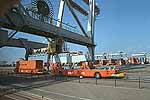 Here, a container
has just been taken off the ship. The driverless vehicle is on its way leftwards, and a new one is coming in from
the right. The intermediate storage area can be seen in the background. The white bridges spanning the container
mountains are automatic loaders. The ship crane is so big, some 100 meters high, that it sometimes causes a radio
blackout beneath it. Because of this, there is an extra wireless network node underneath each crane.
Here, a container
has just been taken off the ship. The driverless vehicle is on its way leftwards, and a new one is coming in from
the right. The intermediate storage area can be seen in the background. The white bridges spanning the container
mountains are automatic loaders. The ship crane is so big, some 100 meters high, that it sometimes causes a radio
blackout beneath it. Because of this, there is an extra wireless network node underneath each crane.
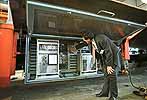 The system
manager for the wireless network is lifting a door on one of the driverless vehicles, pointing out the various
electronic parts. The vehicles have on-board Ethernet and several computers. The assembled body of journalists
is drooling enthusiastically.
The system
manager for the wireless network is lifting a door on one of the driverless vehicles, pointing out the various
electronic parts. The vehicles have on-board Ethernet and several computers. The assembled body of journalists
is drooling enthusiastically.
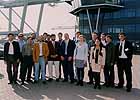 The
day ended merrily. Here are all the journalists, assembled outside the control tower for one last picture before
we, happily smiling, were shipped home again. Yours truly can be spotted behind Natalie, the lady in light blue,
a representative from Breezecom's advertising agency in Belgium. The pictures in this article are partly my own,
partly advertising pictures taken by Europe Combined Terminals.
The
day ended merrily. Here are all the journalists, assembled outside the control tower for one last picture before
we, happily smiling, were shipped home again. Yours truly can be spotted behind Natalie, the lady in light blue,
a representative from Breezecom's advertising agency in Belgium. The pictures in this article are partly my own,
partly advertising pictures taken by Europe Combined Terminals.
Where's the bus? When is it coming? Why isn't it coming? In Helsinki, Finland, they were way ahead of us (at least in June 1999) in Stockholm, with the service to the local commuters. I made a report with pictures from the Helsinki local traffic system (Helsingfors Stads Trafikverk, HST), describing the automatic system that collect all the movements of the buses and trams in inner Helsinki, and report it to the bus stop information signs in the streets. Using a lot of statistic data, HST is able to predict arrival times to within 30 seconds, anytime around the clock.
The system was developed by the Swedish company, Thoreb AB, using radio modems from Finnish Satel OY, signs form other Finnish companies, and Japanese GPS-receivers.
 All
buses and trams in the city are connected to the control centre via radio modems. Three high towers in Helsinki
have been equipped with radio modems covering the inner city. The radio links are on about 450 MHz. The information
signs and some of the traffic lights are also radio controlled. Furthermore the bus is able to negotiate a green
light with the traffic lights on its own, saving a lot of time and money every year.
All
buses and trams in the city are connected to the control centre via radio modems. Three high towers in Helsinki
have been equipped with radio modems covering the inner city. The radio links are on about 450 MHz. The information
signs and some of the traffic lights are also radio controlled. Furthermore the bus is able to negotiate a green
light with the traffic lights on its own, saving a lot of time and money every year.
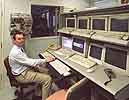 The brain of the system is
a Windows NT server (to the left), polling all the buses via the three 9600 bps modems on top of the console in
the middle. The modems connect to the radio modems in the radio towers via leased lines. The radio modems themselves
have no networking ability, so the Windows computer has to transmit all the buses addresses, over and over again,
and ask for position, speed, etc. But Windows NT isn't powerful enough to take care of the prognostication. Instead
it's a Unix computer (to the right of the server) doing the fortune telling. All positions and times are reported
to maps that the traffic controllers at HST use for traffic planning and management.
The brain of the system is
a Windows NT server (to the left), polling all the buses via the three 9600 bps modems on top of the console in
the middle. The modems connect to the radio modems in the radio towers via leased lines. The radio modems themselves
have no networking ability, so the Windows computer has to transmit all the buses addresses, over and over again,
and ask for position, speed, etc. But Windows NT isn't powerful enough to take care of the prognostication. Instead
it's a Unix computer (to the right of the server) doing the fortune telling. All positions and times are reported
to maps that the traffic controllers at HST use for traffic planning and management.
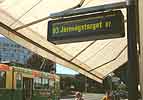 The signs are alphanumeric and connected
to the main system with a radio link. They display which bus line will stop next, and within how many minutes the
bus will arrive. If you sit at home and have to run to the bus, the information is also available on the Internet.
The signs are alphanumeric and connected
to the main system with a radio link. They display which bus line will stop next, and within how many minutes the
bus will arrive. If you sit at home and have to run to the bus, the information is also available on the Internet.
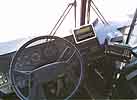 It does look like you would
need a pilot licence to drive a bus these days, and the number of buttons increase all the time. Although Thoreb
claim that their system (in the little white box) has drastically reduced the number of buttons, while at the same
time giving the driver several new services, like electronic mail, less talking in the comm. radio, no more advertising
of bus stops and so on.
It does look like you would
need a pilot licence to drive a bus these days, and the number of buttons increase all the time. Although Thoreb
claim that their system (in the little white box) has drastically reduced the number of buttons, while at the same
time giving the driver several new services, like electronic mail, less talking in the comm. radio, no more advertising
of bus stops and so on.
 And finally,
the goodies for us electronics freaks, the part of the bus electronics package doing the reporting. The white box
is the GPS navigator receiver, the black box is Thoreb's main computer, and the brown box to the right controls
the sign inside the bus and the synthetic voice announcing the next station. The little blue box with SATEL written
on it is the radio modem itself.
And finally,
the goodies for us electronics freaks, the part of the bus electronics package doing the reporting. The white box
is the GPS navigator receiver, the black box is Thoreb's main computer, and the brown box to the right controls
the sign inside the bus and the synthetic voice announcing the next station. The little blue box with SATEL written
on it is the radio modem itself.
The system was still being deployed when I saw it, but its prospects for the future looked good. The commuter's worst pain is normally the chronically bad information, but here in Helsinki they seem to have got a good grip on that.
The American Airlines pilot said “...we will soon be entering American airspace” and I had a gut feeling
of DEFCON Level III and felt like some sort of Russian
missile. That's what Hollywood does to you.
Santa Cruz Operations was a not entirely poor company, that invited me to participate in SCO Forum 1999,
the annual SCO-fest at the University of California, Santa Cruz (UCSC). SCO didn't look out for Linux in time,
and doesn't exist any more. See this article as a piece of history. SCO owned both the UnixWare (that they bought
from Novell) and OpenServer Unix'es, and on Forum, system developers from all over the world met every year to
talk Unix, go to seminars and have a good time.
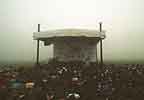 We assembled out
on the lawn the very first morning. The air was raw, and the fog was like soup, but everyone was in a good mood
and the morning's speakers were cheerful guys, even if you couldn't see them very well. But any good systems developer
can take more than that.
We assembled out
on the lawn the very first morning. The air was raw, and the fog was like soup, but everyone was in a good mood
and the morning's speakers were cheerful guys, even if you couldn't see them very well. But any good systems developer
can take more than that.
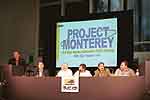 Monterey, the code name
of the project to collect some of the giants in the Unix field (IBM, Computer Assiciates, Compaq et al) and create
a Super-Unix for Intel's (at the time not quite finished) 64-bit processor Merced, was at the top of every agenda.
This is what the press conference looked like, as everyone smiled and slapped each other's backs and said, “This
will be finished before summer.”
Monterey, the code name
of the project to collect some of the giants in the Unix field (IBM, Computer Assiciates, Compaq et al) and create
a Super-Unix for Intel's (at the time not quite finished) 64-bit processor Merced, was at the top of every agenda.
This is what the press conference looked like, as everyone smiled and slapped each other's backs and said, “This
will be finished before summer.”
SCO did a lot to make everyone have a good time, to become friends, and want to come back next year. And we sure had a good time. The days were informal, this was a sneakers-and-backpacks place. People in suits were nowhere to be found. It was very interesting to just walk around and study all the nationalities. Indian women in sari, people from China, Brazilians and so on. Everyone discussing Unix in their respective languages*. “Habblabbla los onsentos system security”, or “Hing song ha Unix”, or “Brasnotchnika dva blivitjko e-mail”. All sorts to be found.
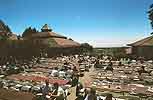
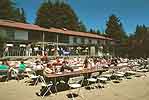 During one of the first lunches I happened to dip my necktie in the mustard, which didn't
make me happy at all. A woman, sitting beside me, said:
During one of the first lunches I happened to dip my necktie in the mustard, which didn't
make me happy at all. A woman, sitting beside me, said:
- Take it off. This is not that sort of place.
That comment kind of set the scene for the rest of Forum. The fact is that no one wore ties and everything possible
was made to cut out the sales pitch and concentrate on technology. The various speakers scorned each other as soon
as any sales talk was detected.

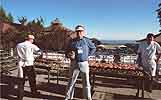 It wouldn't have been America if the barbecues hadn't been fired up all the time. The
beach parties came one after the other, and on the terrace were big, beefy cooks, doing everything to make sure
no one would ever have to go hungry. I simply had to pose in front of one of those Horns of Plenty. This was no
vegetarian's show, for sure.
It wouldn't have been America if the barbecues hadn't been fired up all the time. The
beach parties came one after the other, and on the terrace were big, beefy cooks, doing everything to make sure
no one would ever have to go hungry. I simply had to pose in front of one of those Horns of Plenty. This was no
vegetarian's show, for sure.
The atmosphere was jovial and everyone was in good spirit. All were enthusiastic about SCO's products and seemed to enjoy the good weather and the possibility to be together. And everyone ran Microsoft and Bill Gates down, from the host, all the way up to the CEO, although the language became milder, the higher the person was, such as “Those people 20 miles north of us, who think they rule the world.” The audience got the joke and roared with laughter. The fog that hung over the stage each morning was named “The new release of Windows 2000, Microsoft's latest vapourware.”
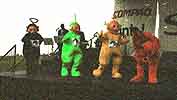 There were all sorts
of merriments on the big stage every morning. SCO has a product called Tarantella, that will change almost any
application to work over the Internet, and turn it into a web application. Four grown-up Tarantellatubbies suddenly
wobbled onto the stage and started dancing, until one of them tore off his tubby-head and screamed:
There were all sorts
of merriments on the big stage every morning. SCO has a product called Tarantella, that will change almost any
application to work over the Internet, and turn it into a web application. Four grown-up Tarantellatubbies suddenly
wobbled onto the stage and started dancing, until one of them tore off his tubby-head and screamed:
- I'm a software developer. I can't take this stupidity anymore. Can I go now?
The host explained that they had consulted all sorts of calendars, the Christian, the Moslem, the Hindu, the Chinese, and the Buddhist, and calculated an average, and found out that the new millennium would start tonight, August 17 at 9 o'clock p.m. Perhaps the world would end, as Nostradamus had predicted, or perhaps the Cassini mission that was to be launched during the evening, would crash on us with its 36 kilos of plutonium. Who knows? Anyway, we would have a big party!
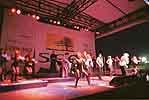 And a party we got.
A big orchestra, the “Dick Bright's SRO” played and performed in front of a thousand-headed, enthusiastic audience.
There were lots of naked legs and ladies with very limited dressing, that brought down the audience's ovations.
But I am at a loss of understanding why it always has to be so loud! My ears were curling up. I retreated a good
distance from the stage, to a more normal sound level. But it is only so much fun to stand in the darkness and
gulp cold white wine form a plastic cup, when the chill pinches your nose and the fog comes rolling in. I went
home and went to bed. Well, the world didn't end, Cassini didn't crash, and Nostradamus was fooled all right.
And a party we got.
A big orchestra, the “Dick Bright's SRO” played and performed in front of a thousand-headed, enthusiastic audience.
There were lots of naked legs and ladies with very limited dressing, that brought down the audience's ovations.
But I am at a loss of understanding why it always has to be so loud! My ears were curling up. I retreated a good
distance from the stage, to a more normal sound level. But it is only so much fun to stand in the darkness and
gulp cold white wine form a plastic cup, when the chill pinches your nose and the fog comes rolling in. I went
home and went to bed. Well, the world didn't end, Cassini didn't crash, and Nostradamus was fooled all right.
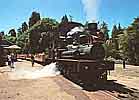 A little bit
north of Santa Cruz, in Felton is an open air railway museum in a place called Roaring Camp. There are two main
attractions: the nicely restored steam engines, and the redwood forest of giant trees. The former are used to show
the latter. But to be able to make ends meet, they also have a trapper market where people can learn about the
trappers in the bad old days, eat old-time food and buy skins, knives and other stuff, that I didn't.
A little bit
north of Santa Cruz, in Felton is an open air railway museum in a place called Roaring Camp. There are two main
attractions: the nicely restored steam engines, and the redwood forest of giant trees. The former are used to show
the latter. But to be able to make ends meet, they also have a trapper market where people can learn about the
trappers in the bad old days, eat old-time food and buy skins, knives and other stuff, that I didn't.

 After a few minutes on track in open carriages, one reaches a grove of redwoods, about
a hundred metres high. This place is so majestic they have dubbed it Cathedral Grove. The man in the middle of
the picture is standing on a tree stump!
After a few minutes on track in open carriages, one reaches a grove of redwoods, about
a hundred metres high. This place is so majestic they have dubbed it Cathedral Grove. The man in the middle of
the picture is standing on a tree stump!
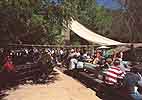 The day ended in
a barbecue (what else!) with “steak-n-baked beans.” The Swedish base camp can be seen closest to the camera.
The day ended in
a barbecue (what else!) with “steak-n-baked beans.” The Swedish base camp can be seen closest to the camera.
The SCO Forum is recommended to anyone who wants to talk Unix and have an enjoyable time.
My collection of articles is large, and it continues to grow. The list contains my articles to date, sorted on year of production.